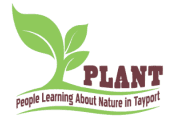This summer, ten community groups across Fife will be undertaking a variety of projects engaging their communities to act in fighting the climate emergency, being awarded a £500 grant from the Climate Action Fife small grants scheme to support them to do so.
Climate Action Fife is a Fife-wide partnership project, bringing together individuals, communities, local government and businesses to tackle the climate emergency and make Fife a greener and fairer place to live. funded by the National Lottery Community Fund’s new Climate Action Fund, it is a partnership between Greener Kirkcaldy, Fife Council, Fife College and Fife Communities Climate Action Network.
Projects are trialling an activity (or activities) aimed at engaging the local community in the climate emergency. Activities are aimed at audiences not already engaged in the climate agenda and will increase knowledge and awareness around the climate emergency and/or increase skills and confidence to take climate action.

Greener Kirkcaldy Development Worker, Craig said: “We were excited to see the interest in this small grant scheme and can’t wait to hear what the groups achieve this summer. The project findings will be used to inform Climate Action Fife’s new climate change engagement toolkit, which will include a resource library of tried and tested climate change engagement activities”
The organisations that have been given funding are:
“Anstruther Improvements Association are delighted to receive a Climate Action Fife Small Grant. The grant will allow us to trial Circular Economy – education, design and craft workshops as part of our Anster Community Development Project. We aim to raise awareness and give local people in the East Neuk the opportunity to take action in fighting the climate emergency. The workshops will include an educational talk on the circular economy in Scotland by upcycling experts Ostrero, and the opportunity to work with a professional artist to design and create your own pencil wrap or mobile phone case using recycled materials. Participants will also have a chance to learn about COP26 and express their views about what priorities leaders should be addressing.”
“We are grateful to Climate Action Fife, which has helped us to provide free ‘plant to plate’ education sessions for local children throughout the summer holidays, highlighting the importance of food miles and sourcing local produce to help tackle the climate emergency.”
“Footprint East Neuk are delighted to receive a grant from Climate Action Fife to help spread the message about the climate crisis within our local area. We will be running a series of workshops for local people on the importance of woodland, regenerative farming and climate-friendly gardening, and encouraging people to make more sustainable choices in their own lives.”
- K107 – Kirkcaldy Community Radio Ltd (K107fm)
“Whilst Kirkcaldy Community Radio (K107fm) may not be the first local organisation you’ll think of for climate action, the climate emergency is not a distant, far away problem: it is here in Fife and we’re seeing the impact already. Utilising the power of local radio, we can find innovative ways to include key messages across our programming and promotional activity both on-air and through our social media platforms. We are also able to support Climate Action Fife to increase awareness and engagement in other events planned in the coming months. As the local community radio station, if significant events are happening in our area, it’s our role to highlight these. K107fm is keen to ensure the climate conversation is heard across the Kirkcaldy area and are proud to work alongside CAF and its stakeholders”
- St Andrews Environmental Network (StAndEN)
- Templehall and Torbain United Parish (Church of Scotland) Kirkcaldy
“This award reinforces our desire to ‘build back greener’ as we look to play our part in helping our community recover from the devastating effects of the Coronavirus pandemic on national and local economies. Massive thanks to Greener Kirkcaldy and the Climate Action Fund Small Grants for believing in our project and giving us the opportunity to work on tackling the climate emergency”
- Touch Community Gardens (Play and Grow Dunfermline)
These organisations will be undertaking their funded projects in the coming months, helping to expand climate awareness in Fife for all ages and combat climate change by reaching out to those less engaged in the subject.
Listen to this excellent podcast from PLANT on gardening which is good for the planet as part of No Mow May. This was first published on PLANT’s community blog page.
Can keeping our garden lawns a bit longer really make a difference for our precious wildflowers and minibeasts which are disappearing from our wider landscapes? In this episode we are exploring this very question as well as the pleasures of rewilding our green spaces. Partners in Fife’s Climate Friendly Garden project talk about why and how they took part in Plantlife’s No Mow May campaign. And Kevin Frediani from Dundee University adds his botanical expertise. You will also hear snippets from our own Tayport Community Garden where we counted our lawn wildflowers for Plantlifes Ever Flower Counts last week to learn what effect No Mow May has had there.
You can listen to the episode on Anchor here or simply search for “PLANT Voices Tayport Community Garden” on your favourite podcasting app.
Resources:
- Plantlife’s No Mow May campaign https://www.plantlife.org.uk/uk/discover-wild-plants-nature/no-mow-may
- Plantlife’s Every Flower Counts citizen science project https://www.plantlife.org.uk/everyflowercounts/
- 2019-2020 results of Every Flower Counts – hinting at the possible impact of future climate change
- Plantlife website: https://www.plantlife.org.uk/everyflowercounts/2020-results/
- The Independent article https://www.independent.co.uk/news/uk/home-news/mow-may-garden-lawn-wildflowers-b1840411.html
- Video of Plantlife’s Trevor Dine’s talk https://www.youtube.com/watch?v=iPfePtmUH2g&t=1833s
- Climate Friendly Gardens project https://tayportgarden.org/2021/02/12/an-introduction-to-climate-friendly-gardens-project/
- Climate Action Fife’s blog about No Mow May: http://climateactionfife.org.uk/no-mow-may-how-the-food-on-your-table-relies-on-the-grass-under-your-feet/
- Recording from Kevin’s talk about rewilding your garden for Dundee Green Health Week May 2021 https://vimeo.com/549257368
- Resources for rewilding Dundee/Tayport on Dundee Botanics page https://www.dundee.ac.uk/botanic/educate/rewilding-dundee/
- Scotia Seeds https://www.scotiaseeds.co.uk/
Pauline from CLEAR writes how growing your own vegetables from seeds is better for the climate in her latest blog.
Since CLEAR became involved in Climate Action Fife growing project, I have become much more aware of the effects of climate change, CO2 emissions, erratic weather and types of plants required for our garden to aid nature and biodiversity.
What I have also noticed is that there are no commercial Scottish seed growers anymore. The trend has been to buy from other areas in the UK or Holland especially. The last Scottish seed merchant business was Alexander and Brown based in Perth and they operated from 1897 to 1981. Seeds and plants are steeped in the history of Scotland as there were so many Palaces, Castles and Estates, where gardens and gardeners were revered. Botanical collections became famous and still can be seen today for example Falkland Palace, Dawyick Gardens and RHS botanical gardens in Edinburgh to name but a few.
Many of these collections had tree arboretums and from there heritage varieties of apple trees are continuing to be popular today. Here at CLEAR Buckhaven growing space, we have over 111 trees with 26 varieties of apple trees alone. Several thousand more are planted in other areas throughout Buckhaven and Methil.
There is a dearth of vegetable seeds produced here in Scotland though, which is strange as hundreds of vegetables grow well in Scotland. Mike Small [Fifes Diet] has suggested: “that many individuals and community groups have been desperate to get hold of Scottish seeds”. Statistics from 2009 shows that there has been a rapid increase in home growing, from 40% [2005] to 70% in 2009. These figures I am sure will have significantly increased due to the current pandemic situation. We know that many vegetable seeds have been named because of their connections to Scotland eg Musselburgh Leeks, Ailsa Craig Tomatoes and Kelso onions. Many varieties of potatoes are also famous and these are now also heritage ones. The islands of Scotland have their own breeds of vegetables and barley crops grown to survive the particular climates of these areas. Shetland cabbage, Bere barley and small oats on Uist for example.
There are many individual growers, all over the country saving their seeds and developing their own variety of plants. Scotia Seeds specialise in Wildflowers and are based in Mavisbank in Angus.
Everyone should be encouraged to come together in the Autumn and Spring to do seed swapping. Community gardens and organisations such as The Common Good Food and Fife Diet have been recommending this practice for many years. It is much more environmentally friendly to grow your vegetables from seeds than from plug plants as this involves the use of plastic trays, transport mileage and water and chemical use which impacts the environment greatly.

At CLEAR we are trialling a Plant stall where we can sell on our surplus seedlings to the public, and it’s very seasonal and environmentally friendly. Details of the plant sales can found on our Facebook page and our website, or get in touch with our partners at Greener Kirkcaldy, Eats Rosyth or PLANT Tayport.
Climate Action Fife is a Fife wide partnership project, bringing together individuals, communities, local government and businesses to tackle the climate emergency. It is funded by The National Lottery Community Fund’s Climate Action Fund. #ClimateActionFife
Karen from EATS Rosyth writes about how you can make your food last longer in her latest blog.
Reducing food waste is one of the quickest ways we can take individual action to tackle the climate emergency. It may feel like a small action but ‘Project Drawdown’ does see reducing waste as one of the biggest priorities in finding a climate solution.
With a third of food grown currently going to waste at some point along the supply chain, we need to consider how we can reduce the waste at the end consumer point. One way to reduce what you waste at home can be by using age old methods of preservation. In the days of fast food, it’s a skill many have left behind but it can extend the life of some of our precious produce and can provide delicious food even when it has gone out of season.
So let’s get pickling!


Pickles are one the easiest ways to keep food fresh for longer, basically all you need is a jar and some vinegar! To make a simple brine use half a litre of white wine vinegar with 1kg of whatever veg you are trying to pickle, eg. red cabbage, beetroot, red onion are good ones to start with. Add 200ml water and tablespoon each of salt and sugar. For added flavour you can add a spice or herb like bay leaves or some chillies. Boil up the brine, add the veg for the last couple of minutes then divide into your sterilised jars. Clean jars are a must for preserving and a quick way to do that is wash in hot soapy water then dry in the oven at around 170C for 15 minutes. They can last for up to two months in the fridge and make a tangy side for lots of dishes.
Jammin’
Just fruit and sugar, what could be simpler. Get the same quantity of fresh or frozen fruit as you have sugar. Mash the fruit over a slow gentle heat releasing the fruit juices, then add the sugar until it is dissolved. (Jam sugar is available that contains pectin to help it set). Bring to the boil for five or six minutes stirring frequently. If it doesn’t look like it is thickening you might need to add some lemon juice. You could use a jam thermometer to test when it reaches 220F but it’s easier to just spread some onto a plate that has been in the freezer and drag a spoon through. If it wrinkles it is ready, if not just continue boiling for longer. When placed into sterilised jars and stored in the fridge it should last up to a month. Chutney is another popular way to preserve veg from your garden or allotment, I am particularly fond of Hugh Fearnley Whittingstall’s ‘Glutney’.
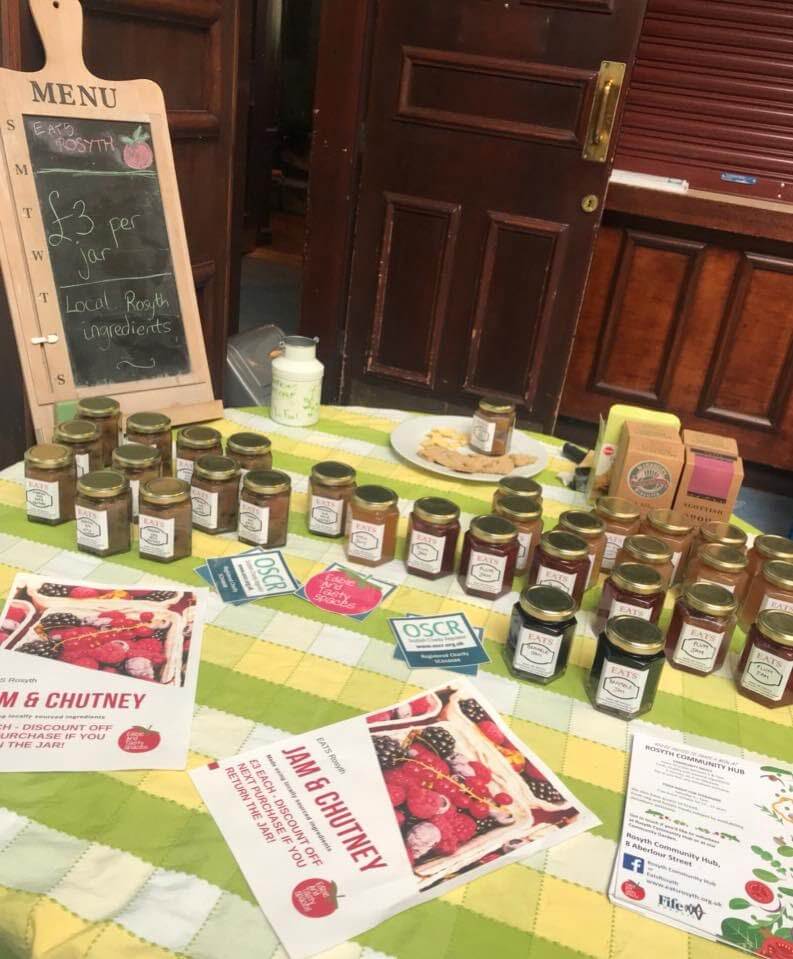
Ferment for each other
The science behind the increasingly popular kimchi and sauerkraut is a process called lacto-fermentation. Lactobacillus bacteria converts the sugars naturally present in fruit or vegetables into lactic acid. Lactic acid is a natural preservative protecting not only the flavor and texture of food but also its nutrients.
The process also makes the nutrients more readily available to the body and beneficial to the gut and digestion. Cabbage, carrots, beets, turnip or radishes are good ones to start out with. For example you can try an easy sauerkraut with just finely shredded cabbage and some salt. Gently massage the cabbage and salt, drawing out the liquid into a natural brine. You can add peppercorns or spices to spices to flavour.
Cover with clingfilm and weigh down to keep the veg submerged. Cover and leave in a cold dark place for five days. Store longer and taste occasionally to see how sour you like it. It can keep in the fridge for up to 6 months but keep in mind it is fermenting and may need gas released every so often!

Other exciting things to try once you have got the hang of preserving are Kombucha, delicious refreshing fermented tea that you can flavour with fruit, or Kefir, fermented milk which reuses kefir grains over and over making continuous batches, again with the added benefit of being great for your gut health! You can also dry fruit in an oven on a low heat, eg. make apple crisps or fruit leathers.


Chill out
Remember your freezer is your friend. By learning the best way to store food to make it last longer in the fridge and freezer you will be saving yourself money and more importantly trips to the shops. Everything from cheese to egg whites can be frozen, be sure to check out https://www.lovefoodhatewaste.com for lots more tips.
Keep an eye out for some great innovative businesses in this area –
ChicP – making dips and hummus from surplus veg
Rubies in the Rubble – make pickles and condiments from surplus fruit and veg
Social Pickle – fermenting and pickling foraged produce
Buckhyne Braes produce from CLEAR Buckhaven
Climate Action Fife is a Fife-wide partnership project, bringing together individuals, communities, local government and businesses to tackle the climate emergency. It is funded by The National Lottery Community Fund’s Climate Action Fund. #ClimateActionFife
Tips on climate friendly gardening and planting summer containers from Fiona at EATS Rosyth. Please let us know if you enjoyed this workshop and help us measure engagement by completing this survery: https://www.surveymonkey.co.uk/r/P6FWZRB.
You can watch the full workshop below:
Jane from CLEAR writes about the least environmentally damaging way to eat meat in her latest blog.
As the extent of climate change becomes increasingly alarming, meat consumption is receiving considerable media attention There is much debate over the exact impact of meat production on the environment. While some organizations claim that livestock farming drives climate change, and we should stop eating meat, or at least reduce the amount we eat to once or twice a week, others state that regenerative agriculture can actually reduce greenhouse gas emissions. Meat from ruminants (mainly beef) was consistently identified as the single food with the greatest impact on the environment, most often in terms of greenhouse gas emissions and/or land use per unit commodity.
The environmental impact of meat production varies enormously due to the wide variety of agricultural practices employed around the world. Industrial meat is the single biggest cause of deforestation globally. This is because farmers are deliberately setting forest fires to clear space to grow industrial animal feed, like soya, for farms back in the UK, (and for cattle ranching), and releasing billions of tonnes of carbon dioxide into the atmosphere, accelerating the climate emergency.
The more we can bring livestock farming back to a natural approach, the closer we come to eliminating the imbalance in the greenhouse gas emissions. “British farmers are leading the way in producing climate-friendly food and we are the only community to set an ambitious target to become net-zero by 2040. People say ‘cut out meat to save the planet’, but this message wrongly implies all farms throughout the world have the same carbon footprint and environmental impact, and so misses the real point”. Stuart Roberts, Vice President, NFU
In 2013, a report by the UN’s Food and Agriculture Organisation showed that beef produced in Britain (and the rest of Western Europe) is two-and-a-half times more efficient than the global average and four times more efficient than some other parts of the world. The UK climate means grass grows really well. With 65 percent of British farmland only suitable for grassland, the most efficient way to turn this inedible grass into high-quality, nutritious protein is to graze livestock. We believe it is far better to buy British meat than to rely on imported alternative proteins from production systems that don’t observe our high values or don’t share our environmental ambitions. Patrick Holden, Director, Sustainable Food Trust
British beef and lamb is some of the most sustainably produced in the world, requiring very few additional inputs. Their grazing lands store carbon dioxide from the atmosphere and provide vital habitats and food sources for some of our most treasured and at-risk wildlife species. Jonathan Foot, Head of Environment, Agriculture and Horticulture Development Board (AHDB).
So, if you want to continue to eat meat and have the least environmental impact:
1. Eat Local Meat – the lowest food miles
2. Buy Grass-Raised Meat – the lowest environmental impact
3. Eat Nose to Tail – so nothing is wasted.
https://www.mentalfoodchain.com/meat-impact-on-environment/
https://www.bbc.co.uk/food/articles/meat_environmentBuy British meat
https://green.harvard.edu/news/red-meat-and-environment
Climate Action Fife is a Fife-wide partnership project, bringing together individuals, communities, local government and businesses to tackle the climate emergency. It is funded by The National Lottery Community Fund’s Climate Action Fund. #ClimateActionFife
Making food good for all in Fife and our planet.
Making food good is everyone’s business. This includes growing and producing food, distributing and sharing it, accessing and eating it and how we deal with waste from food. Everything we do around food in Fife is important to our people, communities, public places, businesses, our economy, and our land.
The Fife Food Summit will take place online on Tuesday 22nd June 2021 from 9.30am – 1pm. The event will be chaired by Pete Ritchie, Executive Director Nourish Scotland, Farmer and Food Expert. Keynote speakers and themed workshops will explore ideas and examples of work that are happening both within and out with Fife to inspire changes we can make.
The Summit will focus on key themes including reducing food waste and keeping good food in circulation, how we can use and procure local and seasonal food more, and work better together to bring about good food for Fife and our planet. It will also launch the first steps towards creating a sustainable climate-friendly Food Partnership and Vision for Fife that is being developed by Fife Council’s Climate Change and Zero Waste Team. It’s a great opportunity to bring people, communities, organisations, professionals, businesses, students, the public and private sectors and anyone interested in influencing our food in Fife.
We will use the online platform HOPIN for this event, which will allow for an enjoyable experience and ample opportunity for discussion, networking and accessing exhibits such as films and recordings in the Expo Booths.
- To register: please click this link to register for the Hopin event. The first time you use Hopin you have to create an account then you can register for the event (by clicking the blue ‘Join event’ button).
- You will get an email confirmation from Hopin titled “You’re in! – Fife Food Summit: making food good for all in Fife and our planet.”. Click ‘Add to calendar’ and you will get reminders before the event and can just click the diary event to enter on the day.
The full registration link is: https://hopin.com/events/fife-food-summit-making-food-good-for-all-in-fife-and-our-planet The event is part of Climate Action Fife, a Fife-wide partnership project between Greener Kirkcaldy, Fife Council, Fife College and Fife Communities Climate Action Network. The event will be hosted by Alan Caldwell Associates.
Jane from CLEAR writes about how important bees are to our everyday lives in her latest blog.
Aware of a buzz in the air? Is it the excitement as lockdown restrictions lift? Could it something else? The swarm season is upon us, so it could very well be honey bees.
They swarm on warm sunny days from May until the end of July (usually between 11am and 4 pm), and often occur after poor weather, as the temperature rises into the high teens. It is a natural reproductive process. After surviving winter, a colony can expand up to 50,000 worker bees in the warmer weather. There is one queen bee in each colony, and she produces queen pheromone. With thousands of bees living together, not all of them receive the queen’s pheromone signals, so they create a new queen. The old queen and flying bees then leave their home to establish a new nest, but with the queen bee not the strongest flyer, they can stop to take a rest, while the worker bees search for a new home.
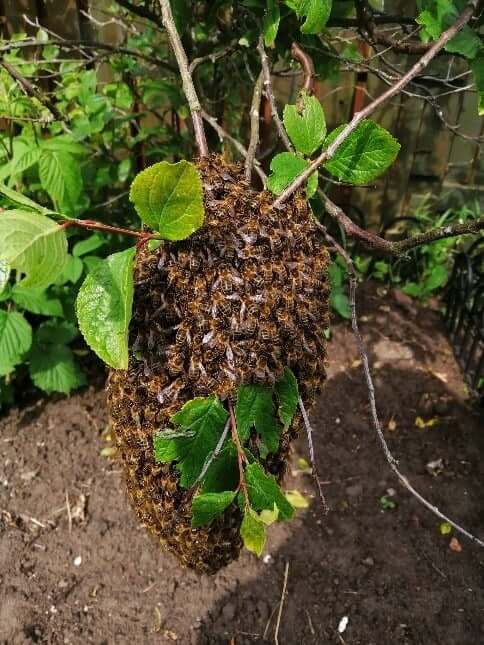

The sight and sound of thousands of swarming bees heading towards you or clumped on your car or a tree can be very frightening, but the bees are more interested in finding a new home than attacking anyone. Before leaving the hive, they gorge on honey, so generally speaking if they are swarming, they are in a semi-docile state, and unless you provoke them, they won’t harm you. However, it is always better to be wary and cautious around bees, and give them a wide berth, just in case.
They are an endangered species, but not protected, so if you do find a swarm or colony, contact a local beekeeper, who will generally be very happy to come and collect them. It is advisable to take a picture to ensure they are honey bees, not another species, as the bee keepers will only take honey bees.
Bumblebee
Wasp
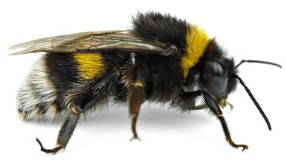
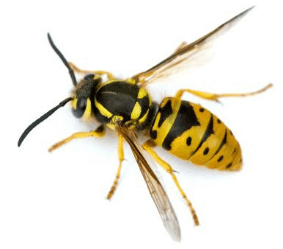
Honey bee
Wood wasp


Climate Action Fife Beekeepers can be contacted on:
Buckhaven And Methil (CLEAR) – Tel: 078 3355 3398
Rosyth (EATS) – info@eatsrosyth.org.uk Tel: 07782 848705 Honey bees are crucial for human life because they make up 80% of the worlds pollinating insects and 1/3 of the food we eat comes from pollinated plants. Without pollination, the plants can’t produce seeds, and without seeds – humans would have only four years to live. (Albert Einstein). Domestic honeybees kept in hives pollinate approximately 34% while the rest is done by wild species.
How much of our food supply do bees pollinate
Climate Action Fife is a Fife-wide partnership project, bringing together individuals, communities, local government and businesses to tackle the climate emergency. It is funded by The National Lottery Community Fund’s Climate Action Fund. #ClimateActionFife
Fiona, from EATS Rosyth talks about #NoMowMay in her latest blog.
Seek out your nearest patch of green grass, whip off your socks, lie all the way back, close your eyes and just breathe. Don’t be shy or embarrassed about it, don’t worry about getting dirty – just be in the moment and give it a bash.
Now, what can you hear, smell or touch? How good does it make you feel? And why has it been so long since you last did it?
Experiencing, enjoying and understanding nature is really as easy as that. Our simplest memories of greenspace and gardens as children are usually laced with daisy chains; handstands, or just wriggling toes amongst the tickling blades of grass. Ultimately, though, they are about a freedom to be in nature without restrictions and rules. The sensory experience is so primal.
Then, it all tends to become a bit more and unnecessarily complicated as we get older – “No Ball Games”, “Keep off the Grass” or “No Camping” signs pop up here there and everywhere. Private spaces become more manicured and managed and even public green spaces become less wild, less adventurous, less..natural?
So, if there are less biodiverse green spaces for us as humans to enjoy freely, what on earth must that mean for the wildlife reliant on them for survival? That is where #NoMowMay steps in. And this 1st of May again signals the start of Plantlife’s annual campaign to ask everyone to put away their mowers for one month of the year and allow nature to return to our green spaces for the benefit of pollinators – and for us humans as consumers of the multitudes of fruit, vegetables and herbs which rely on insects for healthy growth and development. 1 in every 3 bites of food we take is there because of pollinators.

Plantlife’s Every Flower Counts – the largest-ever survey of the humble lawn – revealed in 2019 not only the astonishing diversity of wild flowers growing on Britain’s lawns, but that simple changes in mowing can result in enough nectar for ten times more bees and other pollinators.
Here are some more key findings from this amazing campaign, to inspire you to take the small action of leaving your lawnmower in the shed for a month this May:
- Since the 1930s, we have lost nearly 7.5 million acres of flower-rich meadows and pastures in the UK. Just 1% of our countryside now provides for pollinators.
- With 15 million gardens in Britain, our lawns have the potential to become major sources of nectar.
- The more wild flowers you have in your lawn the more nectar will be produced. One acre of wildflower meadow can contain 3 million flowers, producing 1 kg of nectar sugar. That’s enough to support nearly 96,000 honey bees per day.
- The highest production of flowers and nectar sugar was on surveyed lawns cut once every four weeks. This gives ‘short-grass’ plants like daisies and white clover a chance to flower in profusion, boosting nectar production tenfold.
- Areas of longer unmown grass were even more diverse in their range of flowers, with other nectar-rich plants like oxeye daisy, field scabious and knapweed increasing the range of nectar sources for different pollinators and extending nectar availability into late summer.

What does this have to do with the climate emergency that we at Climate Action Fife’s Climate Friendly Gardens group are working to tackle? The biodiversity of our greenspaces will affect our ability to ensure a sustainable planet for the future, and that starts right down at these grassroots. From them we can grow food supplies to allow food equality for all; we can reduce our individual carbon footprints by growing and eating locally; and we can share and educate through these rich natural resources for a future that is renewable, sustainable and – yes – absolutely bloomin’ gorgeous.
If you’d like to find out more information about how your garden can help against the climate emergency, or join us in one of our community spaces, we’d love to hear from you. Get in touch with us at Greener Kirkcaldy; CLEAR Buckhaven & Methil; Plant Tayport or EATS Rosyth.
Climate Action Fife is a Fife-wide partnership project, bringing together individuals, communities, local government and businesses to tackle the climate emergency. It is funded by The National Lottery Community Fund’s Climate Action Fund. #ClimateActionFife
The rhubarb season is upon us. The first fruit of the year, luscious pink stems, it’s a bit of a Marmite food, you either love it or loath it, and it’s actually a vegetable!
In the Rhubarb Triangle, between Bradford, Leeds and Wakefield, which is famous for the forced rhubarb it produces in winter and early spring, the rhubarb grows so fast you can actually hear it pop when the buds burst open and there is said to be a constant creaking during growing season. I’ve yet to hear it in the garden!
Now in mid-spring, gardens and allotments around the country are being graced with elegant pink stems. This is local seasonal food at its best.
Once confined to pies, jams or a stem dunked into a bag of sugar, rhubarb is having a renaissance in popularity and is added to everything, from soups, salads and gravies to elevated interpretations of jams, gins, cheeses, beers, pickles, ice creams and pies.
Here at CLEAR, we make rhubarb cordial and a selection of rhubarb jams; Rhubarb & Vanilla, Rhubarb & Ginger and Rhubarb & Strawberry, which will be available when our shop re-opens in May.
Here are a couple of my favourite rhubarb recipes that are really easy to make.
Rhubarb sorbet BBC Good Food
A refreshing rhubarb sorbet that keeps well in the freezer – a great way of using up rhubarb if you’ve grown too much!
500g rhubarb
225g caster sugar
Juice of 1 lemon
150ml water
1. Wash, trim and cut the rhubarb into 1 inch chunks.
2. Place rhubarb, sugar, lemon juice and water in a pan and gently cook until soft, around 15-20 minutes.
3. Allow rhubarb to cool then blend mixture in a liquidizer until smooth
4.Freeze in an air-tight container stirring every hour to prevent ice crystals forming until set, around 4-6 hours. Alternatively use an ice cream maker to churn then store in an air-tight container and freeze for around 4 hours until set.
5. Lovely served with baked bananas, a nutty cake (especially pistachios) or on its own!
Rhubarb Crumble Cake
Ingredients
3 oz all purpose flour
3 oz caster sugar
3 oz soft butter
1-2 tsp ground ginger powder
2 eggs
12 oz rhubarb, 1 inch pieces
2-3 Tbsp caster sugar
3 oz all purpose flour
2 oz butter, cold
1 oz caster sugar
Directions
1. Set oven at 190 degrees, line an 8 inch cake tin.
2. Sift flour and ginger into a bowl.
3. Add butter, sugar and eggs beat till smooth.
4. Spoon into cake tin and level surface.
5. Cut rhubarb into 1 inch pieces and mix with the 2-3 tablespoons of sugar.
6. Place over the top of cake batter.
7. Sift flour into a bowl.
8. Cut cold butter into small pieces.
9.Stir in sugar, then press together to form large pieces.
10. Sprinkle over top of rhubarb
11. Bake in middle of oven and bake for 50 to 60 minutes or until a skewer comes out clean.
12. Cool in tin. Slice and enjoy on it’s own or with custard or whipped cream.
Further information local seasonal food available on:
Climate Action Fife is a Fife-wide partnership project, bringing together individuals, communities, local government and businesses to tackle the climate emergency. It is funded by The National Lottery Community Fund’s Climate Action Fund. #ClimateActionFife









